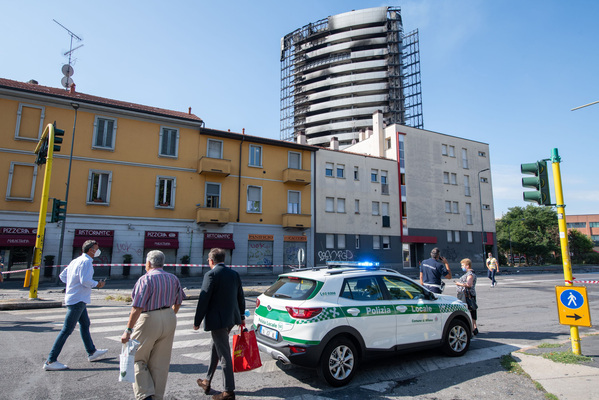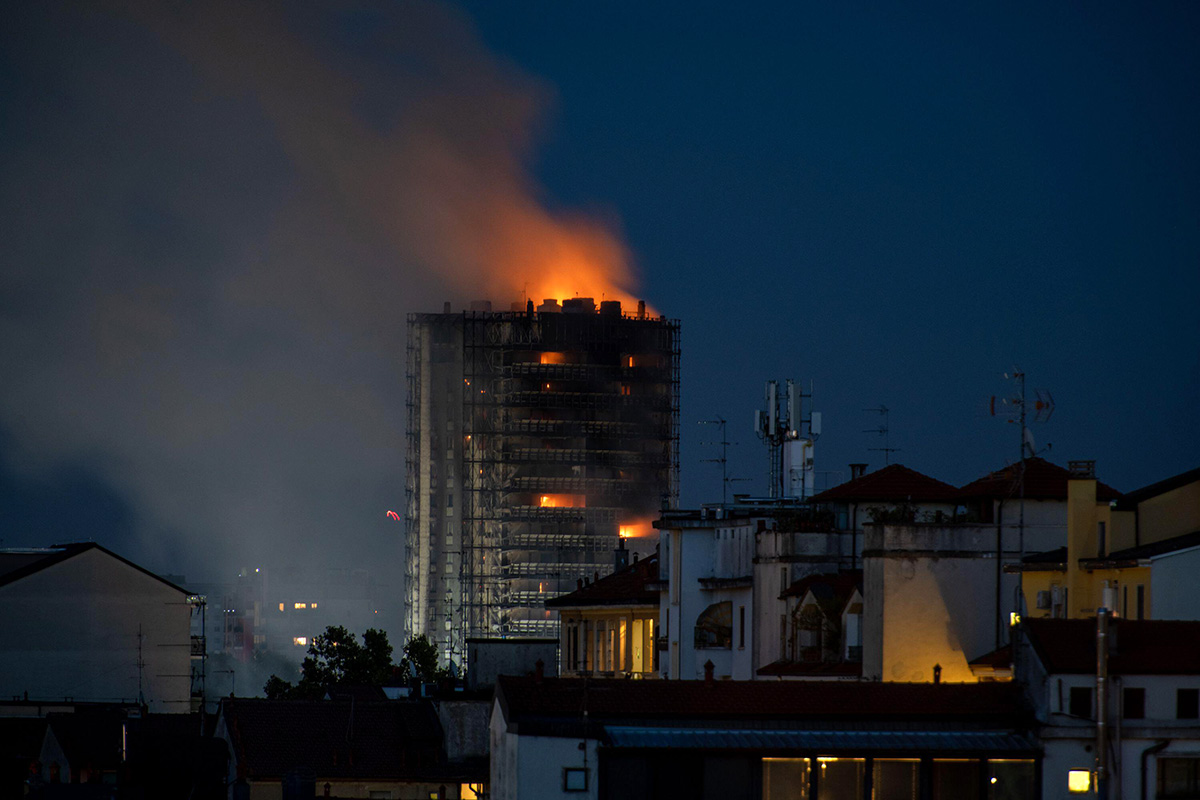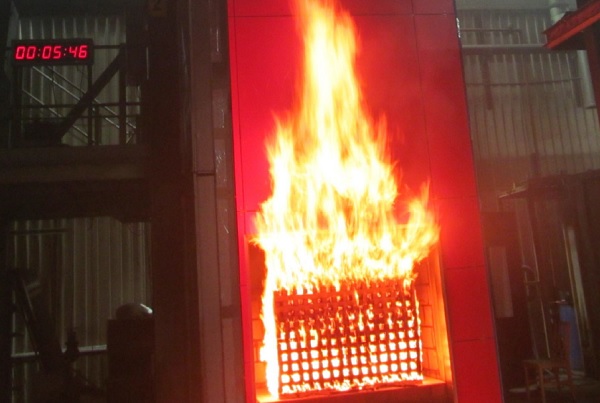‘They are trying to minimise it as a private accident covered by insurance’: the story of a giant cladding fire in Milan
The rapid spread of fire through a cladding system in a block in Milan brought back shocking memories of the Grenfell Tower fire. Peter Apps asks what we can learn from this fire and finds out what happened next
Stefano Plebani lived on the 13th floor of the Torre del Moro in Milan. It was an 18-storey residential apartment block, just to the south of the city’s bustling centre and close to one of its major universities.
Built in the early 2010s, the tower was popular with young people and professionals who worked nearby. There was a mixture of families with young children, couples and single professionals.
On 29 August, there were not many people home. It was a sunny Sunday afternoon, 31°C, in a month when many Italians traditionally leave the city for their summer holidays.
But Stefano was in his flat. At some time after 5pm, two floors above him on the 15th floor, black smoke began to leak out of a balcony. It is not yet known what started the fire – speculation that it was a malfunctioning air conditioner has been reported in the press.
Stefano realised something was wrong when he smelled smoke, which he noticed “had a very plastic smell”. He went out onto the balcony to see if he could see the fire, and heard people from the street shouting at him to get out of the building. He grabbed his wallet and phone, put on a mask for COVID-19 reasons and left.
“The idea was I go outside of the building for 20 minutes, and the fire brigade do their stuff and I’ll get back into my home in half an hour,” he said.
On his way out, he heard no sound of a fire alarm. He does not know whether the building was fitted with one. Coming down the stairs was easy – there was no smoke, or even the smell of smoke.
He was just in time. As he left the building, he took a series of photos on his mobile phone.
They show that just two minutes after he left, flames began to lick up from the 15th floor, igniting the facade and sending huge plumes of smoke into the clear blue sky. A huge fire rapidly developed on the building’s facade – spreading downwards as well as up, rapidly engulfing an entire side of the tower in a fiercely burning blaze.
Flaming debris fell from the building to the road below, setting cars on fire.
Stefano watched as his apartment was engulfed and all his possessions destroyed. The building would continue to burn until the middle of the next morning.
For a British audience, the images from Milan conjured up immediate memories of the horror witnessed at Grenfell Tower in London four-and-a-half years ago.
But there is an important difference between Torre del Moro and Grenfell. No one died in Milan. So what was the difference?
Investigations into the fire are ongoing, but early reports in Italy have referenced aluminium and polystyrene materials on the facade. Certainly, the blaze seems to have spread through the external wall, which appears to have provided fuel to the fire, as well as a route for it to spread.
Like the UK, Italy appears to have a problem with its building regulations. Dr Jonathan Evans, a cladding expert and chief executive of Ash & Lacy, says: “Italy has some of the vaguest regs in Europe – there’s no standard, possibly as a result that there is no harmonised test standard for cladding.”
Indeed, a Fire Safety Europe comparative report of 19 countries written last October found Italy to have some of the most lax rules on the continent. It said the country has no requirement for sprinklers, and no mandatory requirements for external wall insulation or cladding systems.
So perhaps it is not surprising that there are dangerous cladding systems in Milan as well as London.
But the big difference in Milan was a rapid evacuation. When the fire service arrived at the Torre del Moro, they made a conscious choice not to fight the fire. Instead, they focused their efforts on evacuating the tower – making a floor-by-floor sweep of the building to bang on doors, warn residents to leave and knock them down where they did not get an answer.
Once they believed the tower was cleared, they obtained a list of residents from the concierge and systematically phoned everyone to ensure they were out of the building and safe. One resident, who was away on the day of the fire, says he was called by firefighters at 8pm.
Only the next day, as flames died down, did the firefighters actually seek to extinguish the blaze.
This is a complete contrast to the firefighting strategy at Grenfell, where efforts initially focused on fighting the fire in the kitchen where it had begun, before attempting to combat it in other flats and on the outside of the building.
As is now notorious, residents were told to stay put until 2.47am (and some even after that point). By this point, many had lost the chance to escape as smoke filled up the stairs and lobbies and efforts from firefighters to rescue them were unsuccessful in many cases.
Had residents been told to leave earlier, “many more lives” would likely have been saved, the inquiry into the blaze has previously concluded.
So is the fire in Milan evidence that a different outcome could have been achieved at Grenfell with a different firefighting strategy?
For the question of evacuation, there are similarities between the two buildings. Both had a single staircase. Grenfell had no communal alarm and no sprinklers. Residents of the Torre del Moro say they heard no alarm and saw no evidence of sprinklers functioning.
Residents in Milan had also been given no instruction about whether to stay or go in a fire. “We have never done any fire drill or spoken about it,” he says. “For me I just did what my parents always told me, which is to not take the elevator and take the stairs.”
But a potentially big difference is the time of the fire. The blaze in Milan happened in the daytime, when the building appears to have only been partially occupied.
At Grenfell, on the other hand, the blaze started at shortly before 1am, when 293 people were present in the building, many of them children, many disabled and many asleep. Evacuating Grenfell with no fire alarms in these circumstances would have been a much tougher job.

In Milan, Stefano, who left at 5.49pm, believes he was one of the last residents out of the building. He recalls encountering no smoke on his way out and the pictures he took once he left show that the fire had not yet ripped through the cladding by the time he left.
If he is right about this, it means most of the evacuation took place before the rapid fire spread, as residents realised there was a fire and left on their own steam. As Stefano notes, if he had not smelled smoke so early the situation could have been much worse.
“If I had the windows closed and I didn’t smell that smell [of smoke], or even if I was taking a shower instead of checking Facebook from my bed, probably the story would have been way more tragic than this,” he says.
But regardless of the comparisons between the two fires, what Milan – and a series of other non-fatal cladding fires around the world – does make clear is that people die when they stay in a dangerously clad burning building and survive when they leave.
Working out how to evacuate the next tower with dangerous cladding that catches fire in the UK remains, then, the most pivotal task from a building safety perspective.
But while the residents of the tower in Milan may have been well served by the fire brigade on the day of the fire, they feel abandoned by their government in its aftermath.
Roberto Panetta is a successful commercial lawyer, an owner of the Panetta Law Firm and a lecturer at the Bocconi University in Milan. He has lived in one of the lower-rise blocks connected to the tower since 2013. Like the residents of the main tower, he is now homeless.
“This has completely changed my current life, and perhaps also my future,” he says.
Davide Pedone, who also lived in one of the connected flats, explains that while his belongings are undamaged, he has not been allowed back to collect them – apart from one trip to pick up a few essentials.
Both Roberto and Davide are living in hotels, while Stefano is living with his mother.
In the immediate aftermath, help was provided by the community directly – food and restaurant vouchers were offered to those stranded – not by the state. Hotels were paid for out of a sinking fund for building maintenance.
The Milan municipal government did offer to pay for the hotels for a month, but residents must survive on their own resources after that.
They have recently been told they will be offered new properties to buy, with a small discount. But many of these homes will not be available until February and they are above the market average – even with the discount. Many residents will not be able to afford them.
“They [the government] are trying to minimise [the fire] as only a private accident covered by insurance,” says Roberto. “So, in their view, we will be reimbursed by our insurance – the municipality or the government are not required in their view to intervene and to help us.”
Even if insurance does pay out, residents need to arrange a new home without knowing what they will receive.
“We are being asked to sign contracts without knowing what amount will be reimbursed by the insurance company,” adds Roberto. “It’s a complete mess. Without the help of the Milan municipality, without the help of the government, our future is really uncertain. There are 90 families looking for a new life and this cannot be minimised as a private accident.”
They are currently fundraising (see the link at the bottom of the article) to provide life’s basics: from toothbrushes and clothes to laptops and phones.
Residents from the Grenfell Next of Kin support group for bereaved family members recently visited Italy to speak to them and have sought to raise awareness of their plight in the UK – where cladding problems are obviously far wider known.
“The main support that we need now is more visibility, more participation of the press and the TV,” says Roberto. “Because actually in Italy, nobody is taking any notice. There is no attention to our case.”
The residents worry that not enough is being done to identify other dangerous buildings around Milan, and Italy.
“We didn’t have any awareness of what could have happened to the tower,” says Davide. “Now I find myself walking on the street looking at the buildings and apartments and wondering if they are safe. But no one is aware that this could be a problem in Italy.”
Precisely what will happen to the residents who have lost everything in this fire remains uncertain, but for now the future looks bleak.
“Probably I will just leave Milan and go somewhere else and just see my family and parents on Zoom,” says Stefano. “I paid for the [apartment in the tower] partially with savings I made all my life and partially with money from selling my father and mother’s house.”
“It’s quite tough,” he adds. “I hope that this experience will give us strength. And we’re going to survive this in one way or another and we will be probably quite proud of it.
“I have to face the reality that I have nothing left and so I have to change the page and start writing on a blank page. I will try to write something good.”
The survivors of the fire have a fundraiser here.
Sign up for our fire safety newsletter
Already have an account? Click here to manage your newsletters












